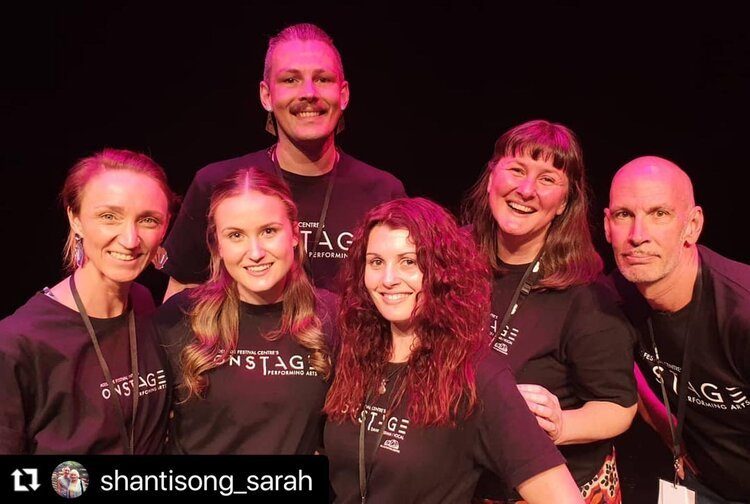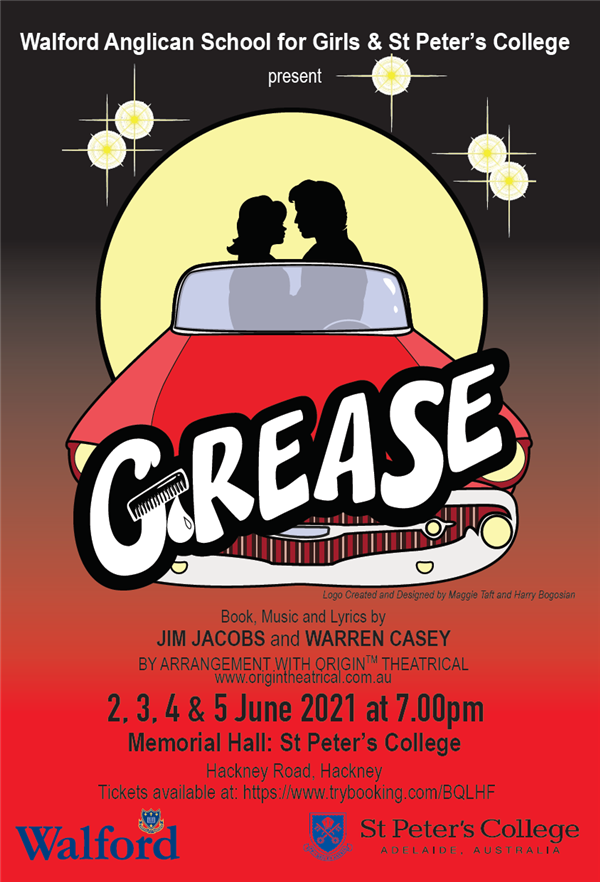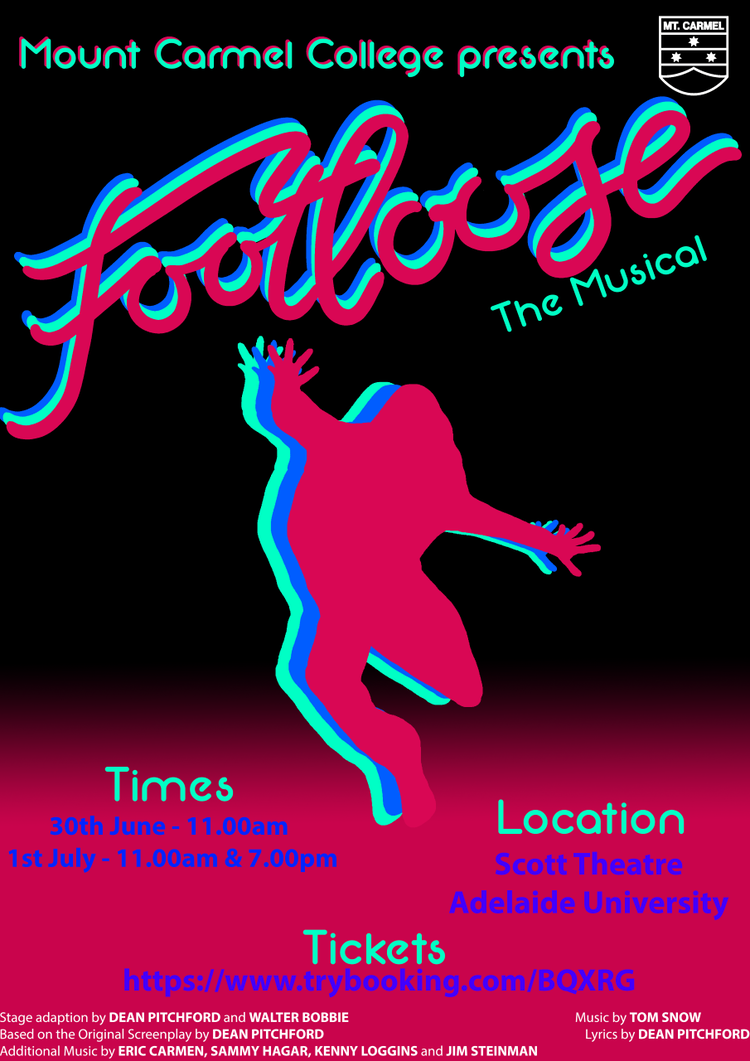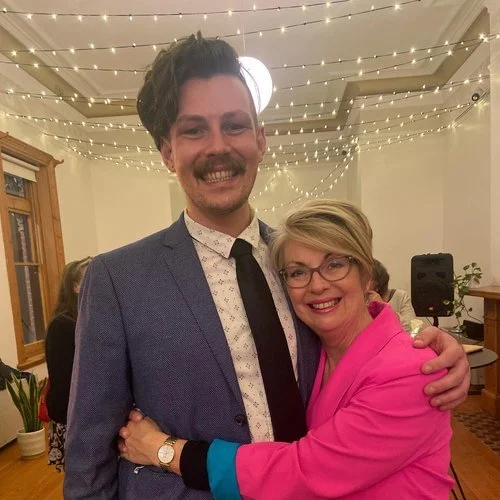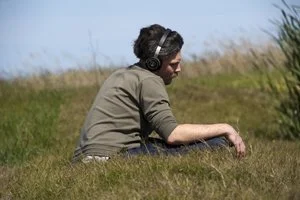Farewell 2021, Welcome 2022
Hi everyone,
It’s likely cliché at this point, but what a year 2021 was.
For myself, 2020 seems like a warmup to this past 12 months. Whereas that year’s university casual teaching transitioned into an online space, 2021 began with a cessation of that work due to COVID-influence budget cuts, placing me in the same precarity as other performing arts colleagues had already been experiencing.
In the absence of academic work, I was fortunate to have several jobs arise throughout this year - amongst them piano teaching, front-of-house for a bakery nearby my house, and fieldwork as part of the 2021 Australian Census - alongside a steady stream of artistic projects.
What follows is a look at these creative pursuits throughout the past year, and several in the pipeline coming up.
In December 2020, I attended Arts SA’s Ruby Awards as a finalist for the Frank Ford Memorial Young Achiever Award. While I didn’t receive the award (deservedly taken home by dancer Jianna Georgiou of Restless Dance Company), I was humbled to be acknowledged by my peers and nominated by Carclew, an amazing youth organisation that delivers a myriad of programs to support young South Australian artists.
Kicking off the new year, I took part in the Adelaide Festival Centre’s OnStage Program as accompanist (alongside Paul Sinkinson) in January 2021. On Stage is a school holiday program allowing aspiring kids, tweens and teens to cultivate an array of ‘triple-threat’ skills, namely singing, acting and dancing. With the guidance of tutors Catherine Campbell (singing), Sean Riley and Jasmin McWatters (acting), and Sarah Williams and Gemma Dandie (dancing), the fortnight culminated in a performance for parents in the Dunstan Playhouse, for which I provided the music on a side stage keyboard.
The team for January’s On Stage 2021 program.
In later January, the final exhibition of Denali: Artists Respond to Music Inspired by Wilderness opened at Michigan Tech University’s Rosza Centre. Having travelled to various galleries around the US, the show featured visual works responding to the music written by composers (myself included) on the Composing In The Wilderness 2017 field seminar in Denali National Park, Alaska. In addition to an article written by Bethany Jones for the Daily Mining Gazette, the Rosza Gallery also produced promotional videos for the exhibition, several featuring Zoom discussions between the composer and visual artists in relation to their works, and another featuring a virtual tour of the Gallery, both of which you can find below:
With the exhibition concluded, the visual artists and composers collectively decided to donate the works to the Alaskan State Museum in Juneau for their permanent collection, a satisying end to an amazing journey initiated and championed by the artists of Elements Arts Group, Charlotte Bird, Susan Campbell, Nancy Hausle-Johnson, Mary Bee Kaufman, Margo Klass, and especially Ree Nancarrow.
Early February saw the release of Cathedrals, an album of field recordings from three Biosphere Reserves around Australia:
Mary Cairncross Scenic Reserve on Jinibara Country (QLD), in the region of Noosa Biosphere Reserve
Wamoon/Wilson’s Promontory on Koori Country (VIC), site of Wilson’s Promontory Biosphere Reserve
Pukumako/Calperum Station on Meru Country (SA), site of Riverland Biosphere Reserve
You can read more on/purchase the album over on Bandcamp.
The return of Adelaide Fringe in mid-February saw me involved in a few ventures.
For most of the season, I worked as part of the Darkfield shows in The Garden Of Unearthly Delights, presented by Realscape Productions. As described on their website:
DARKFIELD is a collection of multi-sensory audio experiences in complete darkness.
The DARKFIELD experiences take place inside purpose-built signature white shipping containers and use binaural audio, sensory deprivation and special effects to place the audience at the center of a narrative completely at odds with the space it occupies.
Immersed in the dark, the total loss of vision causes other senses to heighten, fixating on to every movement and sound.
Later in the Fringe from 17-21 March, I reprised my role as accompanist for Vicarious Cabaret with Spoonerise This at Star Theatres. A fully improvised musical, each show derives its material from audience members’ own lives, with the ensuing hour becoming a weird and wonderful revue charting unknown territory for cast and audience alike.
Additionally, I wrote a profile on Phi Theodoros (AKA Ukulele Dream Girl) for The Serenade Files, where we chatted about her upbringing in the Adelaide Hills, seeking to shift stigma through story and song, and her 2021 Fringe Show ‘Love At A Distance’.
In mid-March, the long-awaited signage for the Murray Bridge Piano Sanctuary was installed, providing information about the site for locals and tourists alike. Avenues to expand the Sanctuary from two pianos to the full vision of eight across the site, and a launch event, are currently being explored, but already the sounds of the instruments are beginning to become quite distinctive as they are individually shaped by weather fluctuations across the years (see the videos below). Many thanks to Tegan Hale for spurring this recent activity!
In April, I performed at Creative Original Music Adelaide, presenting Rollophony. Described on the promo flyer as “kaleidoscopic syntheses of ruined pianola and electronics, exploring the rollography once played on the instruments”, the set utilised audio recordings of pianola rolls that were given to me upon collection of a pianola in Normanville, SA.
Drawing on the sound world of James Leyland Kirby’s (AKA The Caretaker) Everywhere At The End Of Time – a six-an-a-half hour album sonically representing the progressive stages of dementia – I was keen to explore the soundworlds rendered by a failing instrument attempting to re-engage with the music it once played. You can check out the live-streamed performance in the adjacent video.
Following the lockdowns of last year, it had been quite a while since I’d been involved in a musical theatre project, and so June offered a rejuvenating dive back into that world. At the beginning of the month (following several as rehearsal pianist), I played piano for Walford School for Girls and St Peter’s Boys College’s production of Grease, with Trish Hart as musical director. Later, I played keys for Mount Carmel College’s production of Footloose with Pedro Ferreira as musical director. Many thanks to both Trish and Pedro, and each of the production teams, for having me involved with each show!
In June, a new installation, Crepuscule, exhibition at FELTspace Gallery in Adelaide’s CBD. The floorsheet described the work as follows:
Crepuscule is an ecological sound art installation, bringing together livestreams of dusk soundscapes from around the globe into a centralised space.
Drawing the model of Reveil (an annual 24-hour broadcast of dawn choruses on International Dawn Chorus Day), Crepuscule opts for opposing dusk choruses, tuning into publicly-accessible livestreams on Locus Sonus (http://locusonus.org/, a global open microphone network) as the earth rotates toward night.
The sonification of weather data from each soundscape location provides additional creative overlay, achieved through manipulating attributes of audio processing (such as filtering, reverberation, panning, granular synthesis) to result in altered acoustic environments parsed through the lenses of local circumstances.
Through drawing together the sounds of dusk, Crepuscule offers a contemplative space to listen to commonalities and contrasts of twilight soundscapes the world over.
On June 24, I was guest for MUD, a monthly improv gig held at Ancient World on Adelaide’s Hindley Street. Following a chat with coordinator Constatine ‘Kosta’ Stefanou on environmental listening, field recording and ruined pianos, the set was an organic response to tracks 1-6 of Cathedrals released back in February, with Gabriella Smart on Roli Seaboard, Caspar Hawksley on guitar, Miles Farnan on drums and myself on vocoder. After our set, the usual free-for-all improv kicked off, with various folks trying out the settings on the vocoder and Roli.
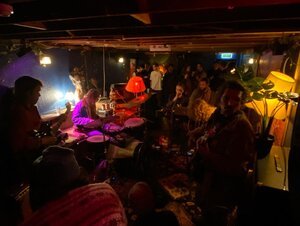
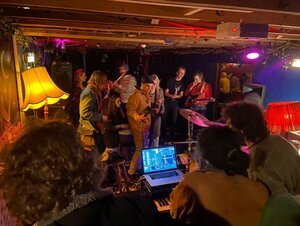
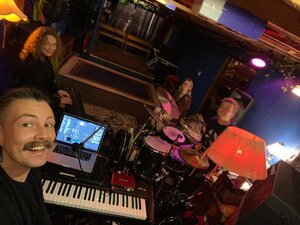
Following a quiet period in July and August (which involve some work as a field officer for the 2021 Australian Census), I started on a new project with choreographer Sam Hall entitled WOMB, a ‘ceremonial dance theatre production seeking reconnection and rebirth.’
Sam describes the work as follows:
Throughout human history, rituals have been an opportunity for communities to gather, gain new insight, and let go of old energies.
WOMB is a new immersive dance theatre production that invites the community to step inside a contemporary ritual and journey through vulnerability towards ecstatic elation. Reality with stretch and morph into an avant-garde dream as the ritual reaches the depths of the human psyche.
WOMB offers audiences an opportunity to connect with one another, shed their old skin, and leave feeling refreshed and rebirthed.
Complementing Sam’s immersive choreography, the score/sound design for the work is arranged for surround sound (ambisonic) setup.
September and October offered an initial development period for the work, situated between DanceHub (20-24 Sept, 11-15 Oct) and The Mill (27 Sept-8 Oct), with showings at The Mill on 6 Oct (as part of their Breakout Residencies, captured in the video posted to the side) and The Odeon Theatre on 14 Oct.
In late September, I was invited to perform for iconic journalist Jane Doyle’s farewell as CEO of Carclew Youth Arts. Sitting on some material from my Carclew-funded travels around the US and Canada, I wrote a new piece, Pacific, for piano and video, with the music accompanying a sunset on the Pacific Ocean at Big Sur, California - a fitting metaphor for a sendoff, I felt.
Post-event at Jane Doyle’s farewell as Carclew Chair (Photo: Tricia Walton)
In October, I also musically directed The Met’s production of Nice Work If You Can Get It, a 2012 show set in Depression-era Long Island, NY featuring new arrangements of Gershwin standards. Working alongside director Selena Britz, choreographer Carmel Vistoli and the orchestra, cast and crew was s’wonderful, with reviews offered by Glam Adelaide, The Barefoot Review and Adelaide Theatre Guide.
More recently, I have been involved in the Country Arts-funded project, Dwell, with choreographer Sue Hawkesley, dancers Tammy Arjuna and Billie Cook, and filmmaker Richard Hodges. Nominally a site-specific screendance project, Dwell investigates habitat encroachment and biodiversity loss at three South Australian sites: Tolderol Conservation Park on the shores of Lake Alexandrina, the hills of Morialta Conservation Park and Goolwa Beach. I wrote a blog entry for the project, describing something of the process and initial recording sessions:
Important for me in site-specific practice is a period of attunement to place. First, I explore existing documentation and resources on a place for both informative and practical purposes, before subsequently visiting and spending anywhere from several hours to a day (or more) cultivating an experiential awareness of the place. One of the key activities in this regard is soundwalking, a method of walking around a place and prioritising the listening experience, becoming aware of the layers, rhythms and relationships of a soundscape and its contributors. I might also make some initial recordings as reference material to reflect on before undertaking larger field recording ventures, but generally aim to focus on forming a mutual sensitive attunement between myself and the place-ecosystem-soundscape.
Distinct to this project is a focus on the perspectives and experiences of critically endangered species associated with each of the sites in question - the Curlew Sandpiper at Tolderol Conservation Park, the Chestnut-rumped Heathwren at Morialta and the Hooded Plover at Goolwa Beach - which in turn provides a direction for my initial explorations at each place, shifting between small-scale and large-scale activities. For each of the Dwell sites, my initial reconnaissance to each location was made in tandem with the dancers involved at each site and Richard.
The first visit, to Tolderol on September 19 with Sue, Tammy and Richard, revealed a rich tapestry of avian arias and vegetative vocalises (encouraged by the steady breeze across the plains and lake system), with distinct land and sound patches striated by levee banks. We focussed on the activity around certain bays of water that were prime habitat for the Curlew Sandpiper, particularly Bay 4. One preliminary recording made here was a hydrophone recording of the irrigation channels, featuring a chorus of water-dwelling insects.
Subsequently, a visit to the hills of Morialta on September 21 with Sue, Billie and Richard situated us within relatively dense bushland, carved up by roads, walking tracks and overhead power lines humming constantly. A light wind rustled the leaves of the eucalypt canopy, with occasional calls from transitory birds (notably galahs) punctuating the mid-morning movements, as we explored the understory habitat of the Chestnut-rumped Heathwren.
On Oct 9, a visit to Goolwa Beach (towards Middleton) with Sue, Tammy and Richard, had us positioned on the sand dune homes of the Hooded Plover, whose nests are typically situated directly on the beachfront. The roar of the surf came to the fore as I arrived (apparently quite calm just prior), requiring a 'grounded' listening experience for me behind the cover of the first dune peaks adorned with coastal shrubs.
In preparing to undertake recordings at each location, I have been keen to make a variety of recordings combining immersive soundscapes alongside the intimate experiences of each flagship animal, thereby providing options in the mixing process to shift perspectives between the two frames. This will likely involve several visits to each place, with some sessions focussed on recording broadscale soundscapes with surround sound (ambisonic) microphones, and others prioritising the delicate sounds that each of the flagship species encounters, using more directed microphone types and techniques (including contact mics and hydrophones).
As I write this, one recording trip took place at Goolwa Beach on November 9. I arrived at 6:30am, hoping to capture some of the dawn chorus of the dunes. Again, I encountered the ocean roar, which I recorded for some time, before moving to the dunes at Goolwa South (that I was familiar with through holidaying in the area as a child, knowing that the preexisting walking paths would minimise my impact on the fragile beach system). Here, I made several takes at various proximities to the beachfront, allowing for contrast between the levels of the dune soundscape and distant surf. With greater appreciation of the soundscape dynamics at Goolwa, my next visit will look to explore the behaviours of the Plover, exploring their localised sound worlds. In the coming weeks, once this upcoming stormy period has calmed, I look to do similar trips to Tolderol and Morialta, before beginning the mixing process and reconvening with the rest of the team.
With recording now having wrapped, the editing stage now begins. Expect more information in the form of a second blog post. and details of Dwell’s exhibition at Goolwa’s Signal Point Gallery as part of the next Solastalgia program in August 2023.
In the field at Tolderol Conservation Park, (Photo: Richard Hodges).
Recording in the hills of Morialta Conservation Park
Finishing off the year, I joined the final creative development of Watershed: The Death of Dr Duncan as repetiteur.
A new work for the 2022 Adelaide Festival (inspired by the 2019 Australian premiere of Considering Matthew Shepard that I produced and conducted), Watershed addresses the murder of Dr George Duncan on University Bridge on the banks of Adelaide’s River Torrens, and the aftermath of thwarted investigations and legislative change resulting in the decriminalisation of homosexuality in South Australia in 1974 (the first juridiction in the English-speaking world). The promo material explains well:
It’s 50 years since the infamous drowning of Dr George Ian Ogilvie Duncan; a moment in time that triggered an alleged police cover-up, a city-wide scandal, national outrage, a Scotland Yard investigation, pioneering gay law reform... and a glaring absence of convictions.
Memorials to the unassuming academic have accumulated in the Torrens precinct of The University of Adelaide - sadness and anger at undelivered justice have gathered across the years - but a nuanced, probing, artistic response on this scale has never been attempted.
Fusing inquest transcripts, press clippings, private correspondence, real and imagined monologues spanning five decades of anti-gay violence, and 30 years of research by local historian Tim Reeves, this joint commission between Adelaide Festival, Feast Festival and State Opera South Australia demands the embrace of all thinking audiences, but is of special importance to this city.
Working alongside composer Joe Twist, librettists Alana Valentine and Christos Tsiolkas, director Neil Armfield and conductor Christie Anderson made for a deeply meaningful experience, continuing an ongoing journey with creative explorations of queer histories and stories, and sensitising me further to the trials, tribulations, sacrifices and suffering endured by our queer forebears in the effort for a more accepting and loving society.
Christos Tsiolkas, Alana Valentine, Neil Armfield, Joe Twist, historian Tim Reeves, myself at the piano, Christie Anderson and tenor Mark Oates presenting at a public talk on Watershed in Elder Hall, 16 Dec 2021 (Photo: Adelaide Festival)
A second development period for WOMB took place at the Adelaide Festival Centre between 17-28 January 2022 as part of their InSpace residency program (more information here). Having the opportunity to revisit the piece allowed for a period of refinement I’ve not often experienced, with development periods often contingent on funding. Sam captures these thoughts well in his interview with InDaily:
“Both of [the previous development] experiences were really fruitful,… Now, we’re letting it settle… but also ruminating over it in the back of the mind and figuring out what we can extend, and what were the really beautiful treasures that we found that we can explore more of.”
After two weeks of revising and reworking the piece sound, in spite of challenges posed by Omicron, an audience of 30 descended into the Drama Rehearsal room for the showing, fully immersed in the amniotic world conjured by Sam and Lily.
Performances of WOMB are anticipated for mid-2022, more information available soon.
The set of WOMB in the inSPACE residency, with dancer Lily Potger centre (Photo: Tom Kitney)
The day following the WOMB residency, 29 January, marked a fairly poignant juncture in the past year. 2021 dealt some heavy blows personally with the deaths of several people close to me: my grandfather Henk, and friends Mark Kinnear, Lily Schubert and Matt Byrne. The past few months have been a time for gently holding space for grief as it arises and cherishing the relationships had with each of these people.
I draw attention to Matt’s passing, a loss to the South Australian theatre community at large, and to each person who became part of his wider Matt Byrne Media family. Having the privilege to musically direct his last major musical, 2019’s Strictly Ballroom, I was honoured to arrange the music and play Keyboard 1 for his final ‘Act 3’ Memorial Concert. Featuring songs from the myriad shows Matt produced over almost 30 years, performed by many former cast members of said shows, the experience of organising the music (many leaving me in tears as I arranged or assembled) and sharing it with a community in mourning was immensely cathartic, a vehicle to pay tribute to Matt’s legacy and for me to make sense of the loss of several people through the year.
Vale Matt, Grandad, Mark and Lily - as sung in Wicked, “because I knew you, I have been changed for good”.
The Act 3 program.
The Act 3 program (cont.)
The Act 3 Band: Thomas Byrne (bass), Emma Knights (keys 2), Brody Green (drums), Patrick Maher (guitar) and me. Note all the posters from shows that Matt produced across his career (Photo: Nick Warner)
Looking ahead to the next few months, there are several ventures on the horizon:
Vicarious Cabaret’s 2022 season at Star Theatres from 2-5 March.
Reviewing shows across the 2022 Fringe season for The Serenade Files
Starting a new arts admin job - more information next time round!
With all bests,
Jesse
